The Most Iconic Shoe Trends of the 1980s: From Jelly Shoes to Air Jordan Sneakers

More from Footwear News
The 80s was a decade filled with big hair, Madonna, neon hues and MTV videos. The era held many culturally significant moments and even more significant fashion and footwear trends that aimed to define the decades after it.
Popular fashions included structural shoulder pads, acid-washed denim, big hair and cozy leg warmers while shoes focused on comfort, functionality and fun fitted with glowing soles, sequins, studs and tassel detailing. Keds, Reebok, Converse, Nike, Eastlands, Sperry, LA Gear and Timberland are just a few of the brands that ruled the 80s, offering up a hungry generation of footwear fans an exciting assortment to survey and try out. The footwear of the time was largely influenced by pop culture and the popular stylistic subgenres that defined the era, including punk and Yuppie culture.
From combat boots to creepers, check out FN’s breakdown of the most popular shoe trends of the 80s.
80s Shoe Trends: Air Jordan
Jordans are a big part of sneaker culture. The footwear style is an institution, synonymous with style and resistance in the face of a fast-paced sneaker market. The first Air Jordan shoe was developed for basketball player Michael Jordan during his stint playing with the Chicago Bulls on Nov. 17, 1984. In his fledgling years, the then-rookie athlete had been approached with contracts from big names like Adidas and Converse. Jordan was pitched the first designs of the signature sneaker and was hesitant, given he wasn’t a fan of the colorway.

Eventually, though, Jordan signed a hefty $2.5 million deal with Nike, three times more than any other deal in the National Basketball Association at the time. With it, the Air Jordan was born. The shoe was subsequently released to the public the next year on April 1, 1985. Nike’s Peter Moore, Tinker Hatfield and Bruce Kilgore produced the sneaker.
Ahead of the sneaker’s official conception, Jordan settled on wearing Nike’s Air Ship style, a sort of pre-Air Jordan. Problems did arise however because Jordan’s black and red colorway of the Air Ship did not match the design of the Bull’s uniforms and both he and Nike were warned that if he did not change them, he would be fined and then eventually suspended.

The first time Jordan wore his own sneaker during an NBA match was in his 11th game, a Nov. 17, 1984 matchup at home against the Philadelphia 76ers. Its white, red, and, black “Chicago” colorway did conform to the NBA uniform regulations and was the version Jordan wore most on the court.
Despite its rocky start, the Air Jordan was released to the public in the mid-80s and was eagerly snatched up by sneaker and basketball fans alike. With the launch of the sneaker, Nike aimed to make $3 million in the first three years. Sales greatly exceeded expectations, however, earning Nike $126 million in one year. Celebrities were also loving the athletic sneaker silhouette.

Jamie Lee Curtis, Kadeem Hardison, Whoopie Goldberg, Ice-T, The Red Hot Chili Peppers and LL Cool J were just a few notable stars who adopted the Jordan style early on, offering their every ensemble a street style-inspired flair. The sneaker filled a gap in the kicks market at the time, providing an athletic-inspired silhouette that boasted style and performance like no other.
80s Shoe Trends: Moccasin
The first known moccasin dates back to 5,500 years, found in Armenia on the border of present-day Turkey and Syria. The moccasin style has a long history that can be traced back to Native American tribes. The word moccasin is derived from the Algonquian language Powhatan and has come to mean any type of sewn shoe with an indigenous-inspired silhouette made of either deerskin or some sort of soft leather.


Today’s moccasin doesn’t do much justice to the varied styles of footwear different tribes would sport to protect the foot while allowing the wearer to feel the ground. Each tribe had its version of the moccasin style made to fit each specific tribe’s needs and surrounding environments with varying differences down to the seams, ornaments, decorations, embroidery and soles.
Generally, moccasins of the time were flexible and often hand-sewn and made of deer skin. The footwear was made of three pieces of fabric wrapped around the foot from underneath. The shoe is heel-less and casual. The differences in the mocassain would help fellow tribesmen identify one another.
The Plains Indians wore hard-soled moccasins, given that their territorial geography featured rock and cacti. The eastern Indian tribes wore soft-sole moccasins for walking in leaf-covered forest ground. The moccasin was so influential to the different tribes that the Blackfoot and Chippewa nations were even named for their particular shoe style. These variations were worn while hunting or traversing surrounding landscapes.
Once the footwear style began to trickle down to the United States, the moccasin acted as an office shoe for both men and women, adopted by the “Yuppie” sub-genre of the time. Thanks to their comfort and durability, the footwear was also worn in school settings with uniforms. In the 1980s, Princess Diana was known to wear mocassins of all kinds while out and about running errands or making public appearances.

The Princess would often style the footwear with classic denim and preppy colorful fashions. Fitted with tassels, beading and faux fur, mocassins in 2023 have gone through major changes. These days, celebrities like Selena Gomez, Emma Roberts, Cameron Diaz, Gwen Stefani, Hilary Duff and even Kim Kardashian have been spotted sporting the updated moccasin style.
Much like the varied Native tribes’ styles of the past, many brands today offer a range of moccasin and moccasin-inspired styles catered to prospective buyers’ specifications. The footwear is available in lace-up, suede and even platform styles from brands like Clarks, Velasca, Aurelien, Yuketen, EasyMoc, Yogi and Visvim among others.
80s Shoe Trends: Combat Boots
Solidified as a rough-and-tumble rebellious silhouette, the combat boot was a massive part of the 80s and into the 90s.
True to its name, the combat boot was made for combat purposes, and used to protect soldiers’ feet from the harsh environments they fought in Wind, mud, sleet and rain, combat boots needed to be durable enough to protect the wearer’s feet from anything and everything, warding off trench foot and other foot-related ailments. These shoes also provide the wearer with grip and added ankle support. The Jefferson Boot, conceived in 1816, was the first “combat” boot of its kind. Through many conflicts, the boot was adapted, updated, and overhauled to produce the modern versions used by the U.S. Army today.


The 80s brought combat boots out from the trenches to the streets largely thanks to the grunge and punk movements in both America and Britain. The artistic movement was much more than music, seeping into fashion, politics, literature and film. Acting as a symbol of defiance, the footwear was integral to the message of anarchy and rebellion preached and practiced by these subgroups. The era was instrumental to the footwear’s success, bringing it into the mainstream.
A rejection of societal norms, combat boots of the time, largely supplied by Dr. Martens, were rugged, masculine, clunky and utilitarian and often laced up for rallies, stage diving and moshing. The music of the era heavily influenced fashion choices. Bands like Sex Pistols (specifically Sid Vicious), M?tley Crüe, Guns N’ Roses, Metallica, Bon Jovi, Van Halen and The Smiths were often photographed in the rugged footwear style, accompanied by big hair and other leather pieces fastened with spikes and studs.
A pillar of the decade, Madonna famously sported combat boots throughout the 80s both on and off stage. Another fixture of the music scene in the 80s, Janet Jackson was also a lover of combat boots. The hitmaker famously danced in the rugged style accompanied by backup dancers in her 1989 music video for her hit “Rythm Nation” paired with an unforgettable militaristic ensemble. Similarly clad, Michael Jackson scaled an empty garage in leather punk-inspired garb in his 1987 music video for “Bad” accompanied by tricked-out black leather combat boots fitted with silver buckles that traveled up the performer’s legs.
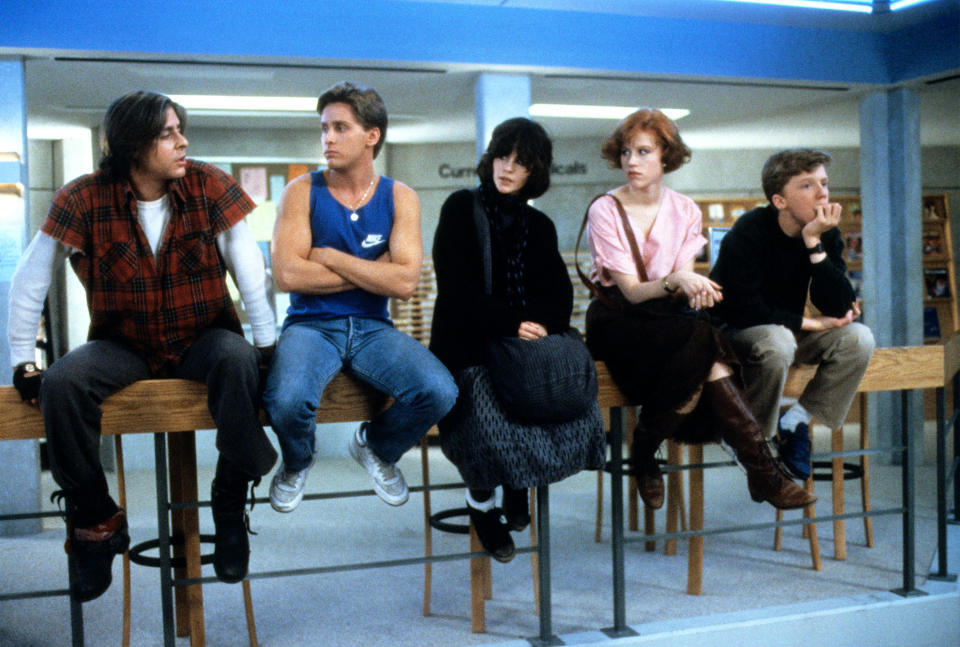

1985’s “The Breakfast Club” mirrored the fashions of the time perfectly, encapsulating and portraying rebellion and youth in the way each character dressed. Anti-hero John Bender, portrayed by Judd Nelson, famously wore combat boots with a red scarf tied around the ankle throughout the film’s 1 hour and 37-minute runtime. The utilitarian style popped up once again in 1988’s “Beetlejuice,” seen in the wacky and wonderful character Beetlejuice, played by Michael Keaton.
Since its conception, the combat boot has had massive staying power, cropping up in music, movies and television throughout the impactful decade.
80s Shoe Trends: Jelly Shoes
The 80s had a big moment for the jelly shoe. While the see-through style was most popular during the aforementioned decade, jelly shoes were invented in the 1940s when PVC plastic was first conceived, offering manufacturers a cheap alternative to natural textiles. During that time, plastic was used to make everything from toys to shower curtains. Footwear designers finally began to utilize PVC for the production of footwear following WW2, creating experimental styles made mainly for the working class that didn’t have much staying power.
Transitioning into the 80s, French footwear brand Jelly Shoes, founded by Nicolas Guillon and Tony Alano, began to capitalize on the virtually untapped market that was jelly footwear, creating a variety of colorful iterations of the clear and playful model for cheap. The footwear makers bought up a bunch of clear Sarrazienne’s ‘fisherman’s’ shoes and transformed them into something fun and wearable that had never been seen before.


Jelly Shoes then closed an exclusive contract with Brazilian global footwear manufacturer Grendene which proved to be a match made in heaven. Following the union, Grendene would go on to become the biggest plastic shoe manufacturer in the world. Soon, jelly shoes would catch the eye of the American public, exploding onto the fashion scene in a major way. In the 80s, Grendene exported their inventive jelly shoe styles to over 48 countries through their brands Melissa and Grendha.
Inspired by the clear and whimsical footwear, designers like Thierry Mugler and Jean Paul Gaultier interpreted the jelly shoe in their styles, stepping into the future with fashion-forward silhouettes unlike anything anyone had ever seen. Many of these styles were embedded with glittering accents, think Mugler’s “Apollo” jelly flats, or lofty heels ala Gaultier. While both French designers were instrumental to the jelly shoes’ success, Gaultier arguably made the shoe what it is today, thanks in part to his many collaborations with sustainable jelly-only footwear brand Melissa.

Although the clear style of footwear went by many names, the Jelly Shoes brand became a proprietary eponym of the shoe, becoming the same much as Kleenex, FedEx and Band-Aid.
Melissa is still one of the biggest, if not only manufacturers of jelly shoes today. The niche brand was founded in 1979 and began with the release of the Aranha model which was based on the fisherman’s shoe silhouette mentioned earlier.


Throughout the brand’s impressive history, Melissa has collaborated with some big names over the years, including Vivienne Westwood, Karl Lagerfeld, Jean Paul Gaultier, Collina Strada, Campana Zig Zag, Y-Project, Thierry Mugler, Alexandre Herchcovitch, Zaha Hadid, Gareth Pugh, Jason Wu, Jeremy Scott and Marc Jacobs among others. The company is the brains behind the original jelly-style shoe.
80s Shoe Trends: Creepers
Perfectly punk and fixed with platforms, the creeper is a beloved silhouette associated with grungier subcultures. Rooted in the worlds of music and fashion, it’s widely believed the silhouette draws its name from Ken Mackintosh’s popular 1953 hit “The Creep” which was embraced by a subculture called the Teddy Boys, who thusly became known as creepers.

Some believe that the crepe in the thick sole may have given the shoes the title creeper. Whatever the reason for their unique name, the footwear silhouette was also exceedingly popular with rockabillies, a popular sub-group in the 1950s whose primary influences were country and rock music.
Before the style took off within these rebellious subcultures, the style was avidly worn by British soldiers during World War Two while trekking through the desert. The thick-soled crepe boots were perfect for helping shield the feat from the elements and the blistering heat. The aforementioned Teddy Boys, otherwise known as Edwardians, would go on to adopt the creeper silhouette full-force. The subgroup would often pair the platform style with dandy fashions including drainpipe pants, button-down shirts and tailored drapey jackets.
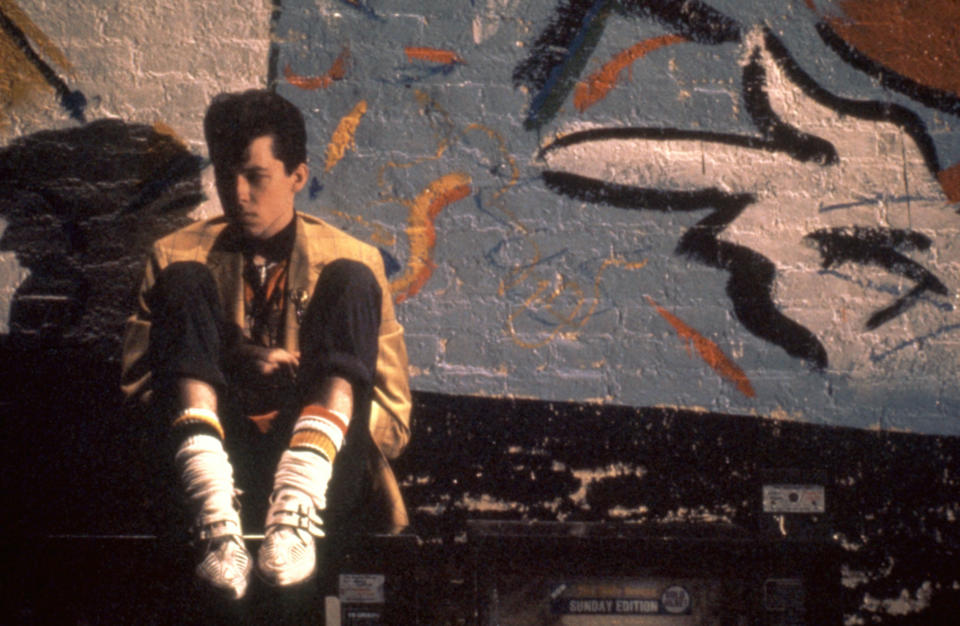

In the early 80s, the style enjoyed massive success, adopted by rockers and punks alike. British fashion designer Vivienne Westwood thrust the style back into the public eye in the 70s and early 80s, reviving the silhouette with leopard-printed uppers and lofty platform soles. Today, the silhouette has been remixed and remastered by a plethora of brands including Puma and Dr. Martens, although its punk origins always remain.
80s Shoe Trends: Dressy Low-Top Shoes
The 80s saw an embrace of workwear-inspired styles. As young people during the decade began to enter the workforce, the “yuppie,” was conceived. A derogatory title, the term described young business people who were considered arrogant, obnoxious and wealthy.

Yuppies were often associated with wearing high-fashion clothing and gloating about their successes, leading a life of unabashed luxury. A perfect representation of this subculture in popular media is the 2000s hit film “American Psycho” starring Christian Bale.
Set in New York in 1987, Bale portrays the role of young and wealthy professional Patrick Bateman who lives a second life as a gruesome serial killer by night. The film is based on a novel of the same name by Bret Easton Ellis which was published in 1991. Both the book and film act as a time capsule for the subgenre, perfectly capturing the aesthetic.
Flats, boat shoes, loafers, oxfords and saddle shoes were popular styles associated with this subculture in the 80s, each silhouette exuding an air of sophistication, aligning with the preppy-leaning subculture. Footwear brands like Sperry and Eastlands dominated the 80s, bringing audiences of the time a range of preppy office-appropriate styles for an affordable price.

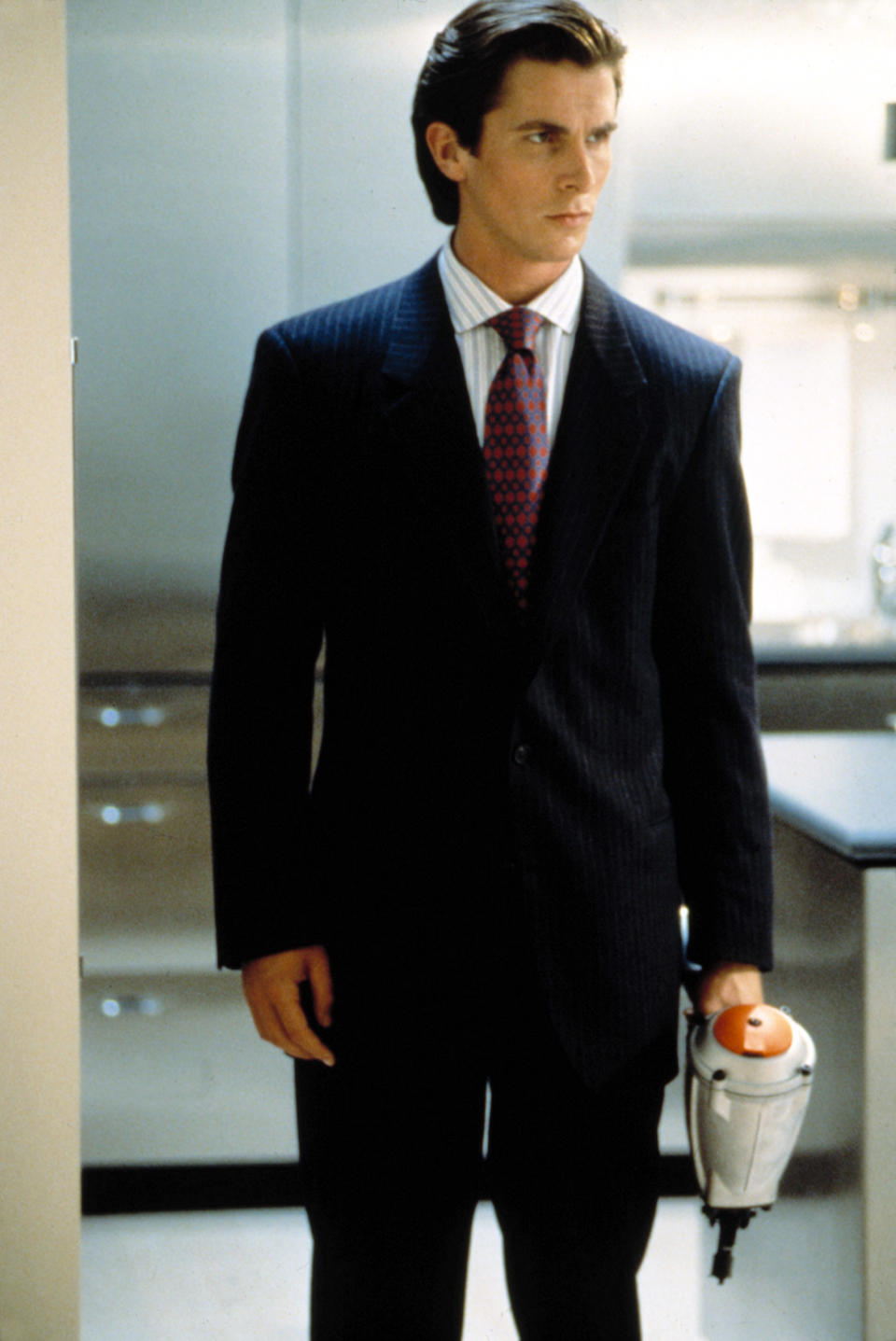
No silhouette was as popular as the penny loafer. The unisex shoe was exceedingly popular, especially among the prepsters. Everyone from Madonna to Blane from “Pretty in Pink,” rocked the style. Conceived in the 1930s, the Weejun loafer, aptly named as a playful rendition of the word Norwegian, was made by American shoemaker G.H. Bass.
The slip-on leather footwear originated from Aurland, just west of Norway, where they became exceedingly popular among Norwegian farmers and fishermen. The shoe’s popularity was no doubt thanks to its versatility. The penny loafer could be dressed up and down, and was extremely comfortable, making it a staple for both men and women. Over the years, the footwear has cropped up on many famous feet including the likes of Audrey Hepburn and Grace Kelly.

Boat shoes were also a mainstay style of the 80s. A distant cousin of the moccasin, another 80s footwear trend, the style is often made of canvas or leather and traces its origins back to 1923. Otherwise known as a deck shoe or top-sider, the footwear was conceived by a New Yorker named John F. Sipe who altered the soles of his shoes, cutting slits in them to prevent slipping while at work. Sipe applied his invention to automobile tires and passed on his footwear idea.
More than a decade later following Sipe’s patent, a sailor from Connecticut named Paul Sperry cut paw-like slits into the bottom of his rubber soles mirrored after the grooves on his dog’s paw pads, creating the first boat shoe. Sperry would go on to launch its Top-Sider shoe in 1935. In the 1980s, “The Official Preppy Handbook” written by Lisa Birnbach named Sperry’s boat shoes as an “icon of preppy style.” Often paired with suits and tailored slacks, boat shoes quickly became forever fixed in the world of preppy fashions. Today, Prince Harry, David Beckham, Ryan Reynolds and Andrew Garfield have all been spotted sporting the nautical style.

As far as performance-driven ballet slippers go, Capezio is a major player in the 80s. The brand stocks a wide range of dancewear for a multitude of dance genres beyond ballet, including jazz, tap, lyrical and modern. However, in the 80s, their Jazz shoes reigned supreme. Similar to dress shoes or oxfords, the style featured sturdy leather uppers, pointed almond-shaped toes and lace-up closures. The style came in a variety of colorways, from baby blue to white, and was fitted with short stacked block heels.
At 17, Capezio’s founder, Salvatore Capezio, opened a small shoe repair shop. Following its humble beginnings, Capezio grew massively, garnering widespread respect and notoriety in the world of dance. In the 80s, Capezio was leading the way with shoes, leotards, dance tights, bags and legwarmers, keeping up with the jazzercise craze of the time. These items were exceedingly popular among rock idols, models and pop stars among others. During this time, Capezio’s products graced the glossy pages of the likes of Elle and Cosmopolitan. Dressed up with a skirt or down with denim, the Capezio jazz shoe made for a versatile staple.
80s Shoe Trends: Cowboy Boots
Trickling in from the late 70s, the cowboy boot trend was exceedingly influential in the 80s. As you might expect, the style’s history is shrouded in mystery, backed by legends and folklore. Although not much is known about the rugged footwear, people have traced its origins back to Texas or Kansas. The riding boot was inspired by the vaquero-style boot brought to America in the 1600s by the Spaniards.

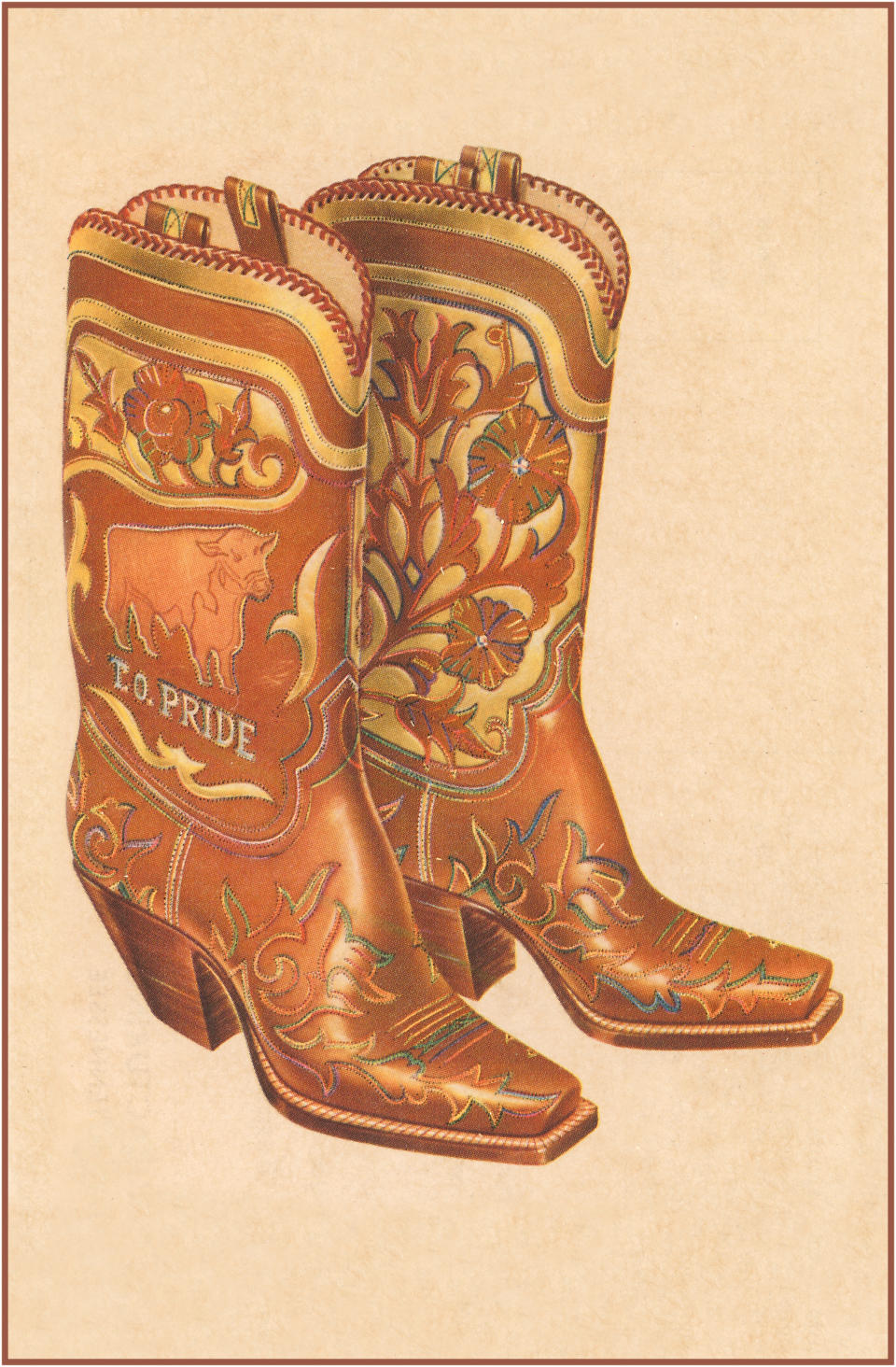
During the end of the Civil War in 1865, cowboys of the time would wear clunky military boots that weren’t great for riding horses or trekking through brambles and creeks. Cowboy boots were birthed out of necessity, made with specific cowboy-centric details in mind. These boots were crafted of thick and durable leather uppers The boots needed to sit higher up on the legs to protect the legs from the underbrush and the elements.
Additionally, they needed to be scalloped in both the front and back so that the wearer could put them on more easily. These boots also needed to be loose enough on top so that the wearer could slip them off quickly if needed. Elongated pointed toes were also added to the cowboy boot so that the foot could easily slide into stirrups while slanted heels fitted to the boots acted to aid the wearer while mounted on a horse, gripping the stirrups to prevent slippage during long rides. The stitching on the outside of the footwear, although mainly decorative, also keeps the leather from bending while preserving the boot in a firm shape around the leg.
From their conception, footwear underwent various changes, depending on the maker and wearer’s preferences. During the 19th century, more advanced changes were made to the footwear’s silhouette that enhanced the boot’s utility and comfort. The toes were made more narrow so that they could easily slip into stirrups. The footwear began to gain popularity during the 1940s, when the Western genre took off.

Fast-forward to the 80s, the cowboy boot was on-trend and better than ever. From Studio 54 party-growers to Andy Warhol, it seemed like everyone was getting in on the Western craze. Paired with dresses, skirts and denim, the footwear imparted a carefree and rugged appearance that other styles lacked.
Famously, Princess Diana issued the cowboy boot an aristocratic seal of approval during the late 80s. The former Princess of Wales wore the style in brown, accompanied by a baseball cap, black blazer, and white jeans to a polo match in Windsor, Eng. in 1988. The ensemble was a controversial one at the time given its informal nature.
“I’m Coming Out” songstress Diana Ross was photographed many times in cowboy boots, often fitted with fringe, during her Studio 54 days usually accompanied by striking jumpsuits. Dolly Parton, Johnny Cash, and Billy Ray Cyrus became style icons in the 80s, bringing country music and the aesthetics that came with it to the forefront of culture. Parton’s larger-than-life personality and rhinestoned wardrobe were particularly influential to the popular culture of the time, cementing her as an icon of both the fashion and music scenes.


The “9 to 5” songstress was photographed countless times in cowboy boots in the 1980s, in styles ranging from white leather to denim. Much like the popular combat boots of the time, cowboy boots represented rebellion, defiantly rejecting femininity with a rugged style made for traversing wild landscapes. This attitude mirrored the youth of the 1980s during the Reagan era, embodying the pushback against conservative ideals.
Today, cowboy boots are made out of a variety of textiles beyond leather including alligator, snake, lizard, and even buffalo skin. Today, Tecovas, Rhodes Footwear, Ariat Boots, Frye Boots and Lucchese Boots offer more traditional-looking cowboy boots for purchase that come in a variety of colorways and prices. Brands like Ganni, Paris Texas and Prada are aiming to change up the cowboy boot game, offering up unique western silhouettes that redefine the genre.
80s Shoe Trends: Canvas Sneakers
The ease of canvas sneakers came with the embrace of casual and sporty footwear during the 80s. Whether running errands or getting a quick workout in, the canvas sneaker is and was universally loved for just about every situation. While there are a variety of sneakers crafted of canvas, Keds and Converse ruled during the 80s, widely embraced by people of all ages and backgrounds.
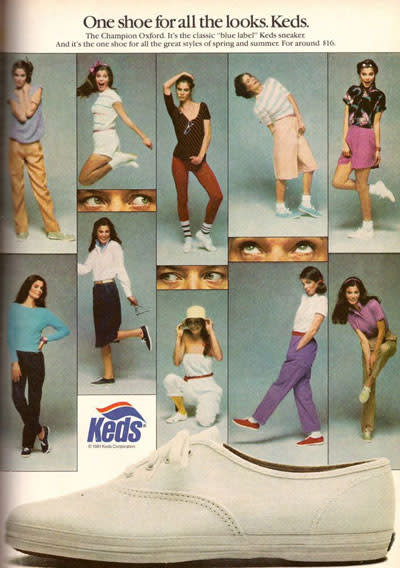
Keds was founded in 1916 but their popular all-white canvas style didn’t reach its peak in popularity until the 80s and 90s. Paired with denim and dresses, the style was cheap and fashionable, appealing to everyone thanks to its all-white coloring. Teens of the time would accompany their Keds with chunky socks and friendship pins fixed to the laces.
The rubbery tread on the sneaker’s sole gave the shoe its name because it makes little to no sound when worn with socks. The style was so popular that it was featured in the 1987 movie Dirty Dancing, in which Jennifer Grey’s character “Baby” wore Keds’ “Champion” sneakers. The style rose in popularity following the film cameo. Many cheerleaders also wore Keds as part of their uniform from the mid-1980s to the mid-1990s. The sneaker became a symbol of coolness among the younger generation of the time.
“We all know the iconic scene with [Jennifer Grey as Baby] dancing in her white Champions,” said Keds’ CMO, Emily Culp to FootwearNews. “It drove over 10 times the average revenue growth for us [at the time].” She added, “The brand is 101 years old. It’s always been about female empowering and embracing your moxie in fashion. [Those shoes] were a key part of what made ‘Dirty Dancing,’ and you can see the impact [that it had].”
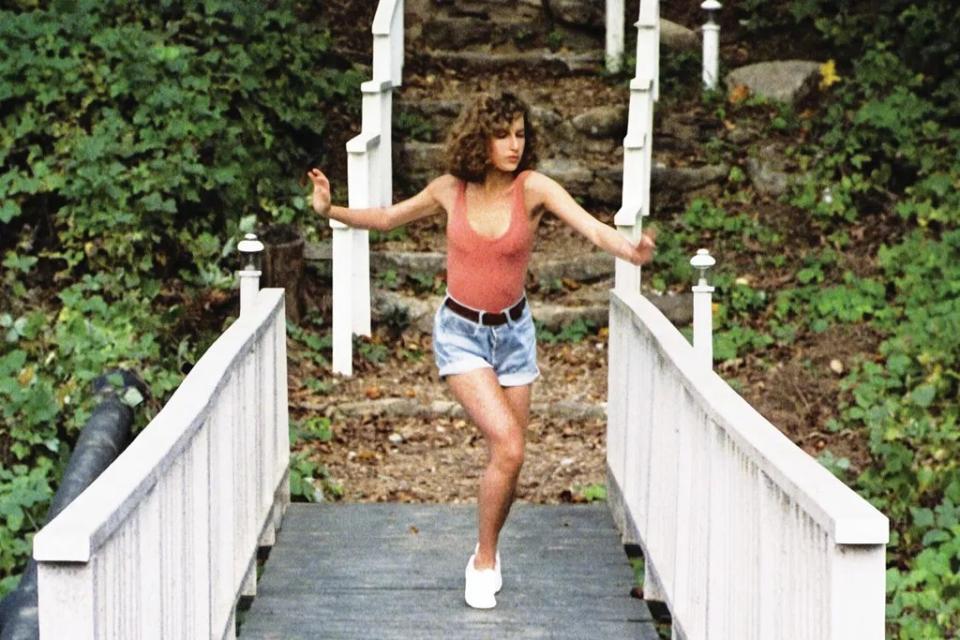
Keds footwear offerings were the first mass-marketed casual athletic shoes, and thus, they became known as the original “sneakers.” The brand’s offerings mainly include sneakers featuring canvas uppers and vulcanized rubber soles that give the shoe durability and traction. Since Feb. 2023, Keds has been owned and operated by Designer Brands.
Converse was also an exceedingly popular canvas sneaker brand in the 80s. Before the footwear’s popularity, Marquis Mills Converse founded the Converse Rubber Shoe Company back in 1908 in Malden, Massachusetts. Although the low-top styles were popular, the brand’s high-top silhouette reigned supreme. A few years later in 1917, the company designed the forerunner of the modern All-Star shoe that was marketed under the name of “Non-Skids.”
The shoe was comprised of non-slip rubber soles and breezy canvas uppers. The style was made for basketball players. Although the All-Star sneaker wasn’t the brand’s first soiree into the shoe world, the style was revolutionary for its time thanks to certain features that gave it a proverbial leg up over competitors. In the 80s, metalheads were often spotted lacing up the canvas style among many subcultures thanks in part to its accessible price point and versatility. Converse’s Fastbreak was also popular in the 80s. Although it wasn’t made of canvas, the style was a basketball sneaker with foam-backed nylon and leather upper.


Converse Chuck Taylor All Star high-tops were seen often in music videos, films and in popular culture. Movies such as “Back to the Future” and “Ferris Bueller’s Day Off” were among some of the films where the characters can be seen wearing canvas high-tops.
80s Shoe Trends: Colorful Sneakers
While canvas-crafted sneakers seemingly dominated the 80s, increasingly athletic leather and mesh footwear options began cropping up. This shift likely aimed at capitalizing on the broader cultural shift of self-improvement with aerobics and fitness at the forefront of popular culture from film to music. The decade’s fashion was all about glitz and drama, a stark contrast to the relaxed fits and flairs worn in the 70s.
High-top or otherwise, new sneaker offerings often came in vibrant colorways, indicative of the aforementioned bold and glamorous designs of the times. Adidas’ Stan Smith, Reebok’s Freestyle, Vision Suede High, Converse’s Star Tech and Kangaroo sneakers were just a few hot styles that conquered. Often affixed with bold graphics, these sneakers were loud and in your face, boasting an undeniable swagger.


The shift toward colorful sneaker culture in the 80s was influenced by a myriad of factors. A short decade after hip-hop was born, the genre’s biggest names like Beastie Boys and Run-D.M.C. were known for their clothing and their endorsement deals with brands like Adidas, ultimately popularizing streetwear sneakers. A greater interest in the skateboarding scene also began in the 80s, cultivating a need for functional footwear that could withstand contact with the board and pavement. Additionally, the 80s saw a rise in the resale and collection of sneakers.
Most notably though, brands like Nike, Reebok and Adidas began to innovate, shifting towards technology made for owning the basketball court. In the mid-1980s, Adidas unveiled sneakers with new and improved stabilization dubbed Torsion technology. The new stabilizing feature included a flexible bar in the mid-foot of the shoe.
As the shoe bent, the bar offered the wearer added support from the forefoot down to the heel. The decade also marked the release of Reebok’s Pumps style. The shoe was the first. of its kind, designed with an internal inflation mechanism that regulated a unique fitting cushion in the lower and upper tongue to provide locking around the ankle.

Innovations in tow, these vibrant sneaker creations cropped up in loads of 80s media including 1984’s “The Terminator,” 1985’s “The Goonies” and 1984’s “Beverly Hills Cop,” among others. 80s legends like Billy Idol, Prince, Madonna and Boy George all opted for striking sneakers every now and again.
80s Shoe Trends: Timberland Boots
Timberland’s 6-inch Yellow Boot is certainly a main player in pop culture. The silhouette is instantly recognizable, drawing a massive cult following thanks to its sleek and sophisticated utilitarian-inspired silhouette that can be paired with just about everything.
During the brand’s early stages, Timberland made footwear primarily for the working class, especially laborers who worked out in the cold. As the institution entered the 80s, Timberland began creating more fashion-forward silhouettes to keep up with the ever-changing market.
The ankle-length style is practically synonymous with rappers and rap culture. Prominent artists who featured them in songs or music videos included Wu-Tang Clan, Nas, Tupac Shakur, The Notorious B.I.G., and Jay-Z. B.I.G was heavily tethered to the brand’s laidback aesthetics. He even name-dropped the boot in his song “Suicidal Thoughts” and again on “Friend of Mine.”

In an article posted in 2016 by GQ, Wu-Tang Clan’s RZA spoke on the boot’s popularity as it relates to rap. “In my opinion, the trend first started in the very late ’80s to early ’90s. I think one of the bands that really brought Timberland boots to the forefront was Wu-Tang Clan. In all of our early videos, whether it was Method Man, ODB, the RZA, the GZA, you see the Timberlands stomping.” The silhouette has continued to enjoy widespread fame thanks in part to major players in the hip-hop field. “They were cool, affordable, durable, and kept you warm,” said RZA.
The Timberland brand was conceived in 1933 by a small New England-based shoemaker called The Abington Shoe Company. According to NBC, about 80% of all the products Abington Shoe sold were Timberland boots by the late 1970s. According to an article published by Indiana University, this prompted the company to change its name to The Timberland Company in 1973. Timberland’s 6-inch boot continues to be a best-seller for the brand.
The ankle-length boot was designed more than 40 years ago and remains a best-seller for the brand today. The utilitarian closet staple featured neutral calf-high uppers in a striking bright yellow lace-up silhouette, complete with bulbous rounded toes, ridged rubber tread and waterproof platform soles in tan.


Additionally, the classic style is crafted from premium leather and bound together with waterproof seam-sealing that helps to keep the wearer’s feet dry. Otherwise known as their “Original Yellow Boots,” Timberland’s Basic 6-inch Boots have been worn by many celebrities, including Rihanna and Teyana Taylor. The boot was introduced in 1973 and has since become a cult classic.
Related:
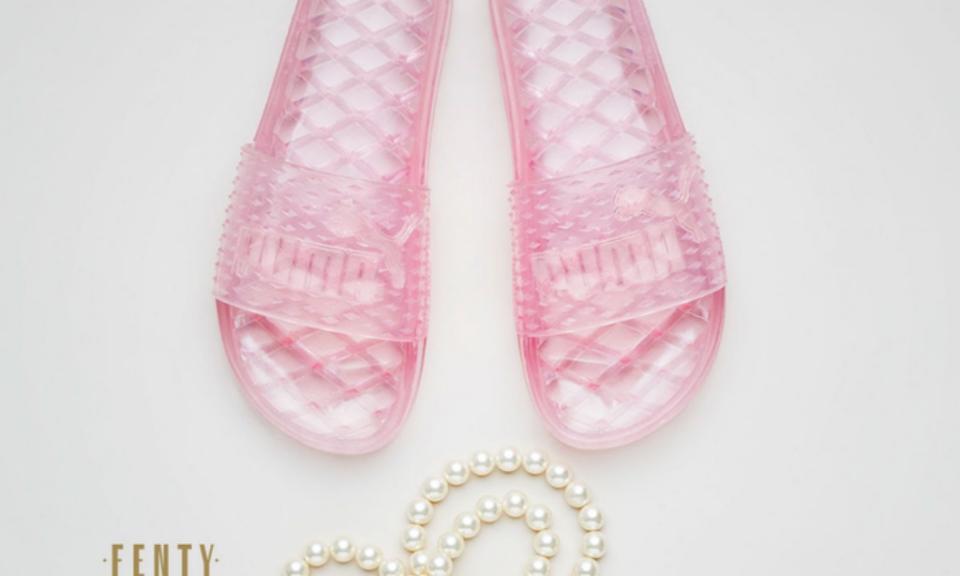
How to Wear Rihanna’s Fenty x Puma Jelly Slide Sandals
Launch Gallery: Dockers and Malbon Golf Look Back to the '80s in New Collaboration
Best of Footwear News
Sign up for FN's Newsletter. For the latest news, follow us on Facebook, Twitter, and Instagram.
Solve the daily Crossword

